- Home
- Feature Articles
- 'Valiant Lynx'. Lo + del año.
"VALIANT LYNX". The most of the year
Thursday, June 14, 2018
Number: 64
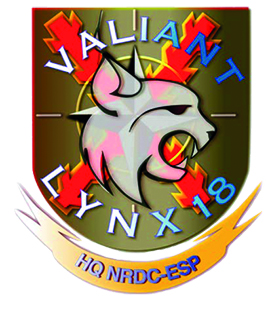
The "Valiant Lynx" exercise was the Spanish Army's main commitment to NATO in 2018 and its largest exercise of the year. Its purpose has been to verify that the Spanish Army is prepared to face a high intensity military operation, applying NATO procedures in the planning, direction and execution of the same. This is very important, as standardised systems and procedures allow all members countries to quickly integrate into Alliance's command structures to take part in multinational operations. To achieve this desired readiness and interoperability, command and control structures must be prepared from the highest to the lowest level as a vertical assessment.
At the Valiant Lynx, NATO's High Availability Headquarters (HQ NRDC-SP) in Bétera, Valencia, was responsible for leading the fictitious operation to restore the territorial integrity of a NATO member country at the Corps level. At the division level was the San Marcial Division General Staff, located in Burgos, and at the brigade level, the 12th "Guadarrama" Brigade's general staff was located in Madrid. The 11th "España" Calvary Regiment, located in Zaragoza, contributed with a Battle Group level Command Post. These last two units were also the manoeuvring units responsible for the execution of the planned missions.
The Field Artillery Command's General Staff (MACA in Spanish) from Leon set up a Command Post to bring the fire targeting and fire support element to the structure of the Corps level Staff and one of its units, the 11th Field Artillery Regiment, did the same with the division level Command Post to bring the fire management element to the "San Marcial" Division.
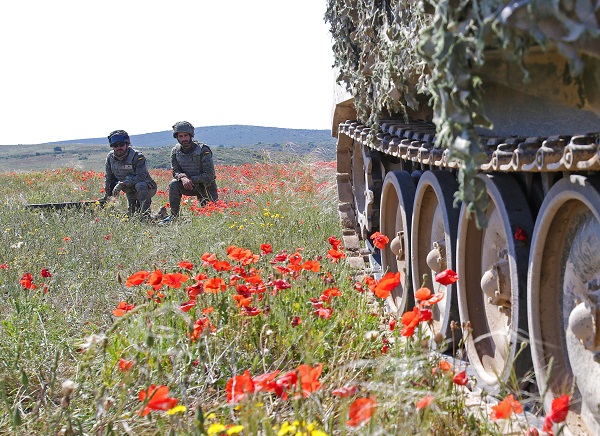
In addition to these units, the exercise also involved other multinational General Staffs, such as the NATO Land Command, based in Izmir, Turkey, or the NATO Force Integration Unit of Estonia, as well as two mechanized brigades, one Portuguese and one Greek, both units affiliated to HQ NRDC-SP.
For HQ NRDC-SP, this exercise has been the culmination of its training as an Army Corps General Staff, prior to the start of preparation for its new role as Joint Force General Staff, which it will assume after the summer.
For the Army, it has meant the recognition of its capacity to integrate into multinational structures and to participate in operations aimed at protecting the freedom, rights, well-being of citizens and national interests wherever it is necessary.
1 Evaluate
The exercuse has served to carry out an internal evaluation by the Training and Doctrine Command of the audience trained in the exercise, both in the CPX and LIVEX phases.
2 Planning and directing
- NATO Rapid Deployment Corps' General Staff (Valencia)
- "San Marcial" Division's General Staff (Burgos)
- 12th "Guadarrama" Brigade (Madrid)
- Field Artillery Command (MACA in Spanish) (León)
3 Execute
- 12th Brigade Units
- Units of the 11th "España" Cavalry Regiment (Zaragoza)
4 Inject incidents
Work of Exercise Control Centre (EXCON), composed of more than 150 military personnel, which injected more than 350 incidents to be resolved by the General Staffs and their units. There were also incidents generated by the GC components of the Castillejos Division, the 10th "Guzmán el Bueno" and the Logistics Brigade.
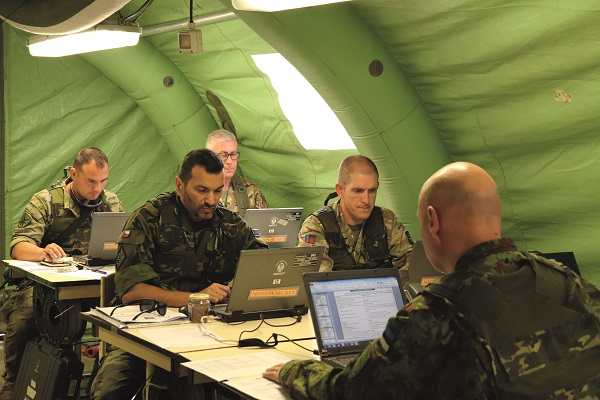
- Zaragoza
- 12th Brigade (at CENAD 'San Gregorio')
- 11th Cavalry Regiment "Spain" (in the base "San Jorge")
- Torrejón
- Combined Air Operations Centre at Torrejón Air Force Base
- Chinchilla
- CGTAD
- 1st Military Police Battalion
- CGTAD Support Battalion
- CG San Marcial Division
- MACA
- MATRANS
- Bétera
- Exercise Control Centre (EXCON)

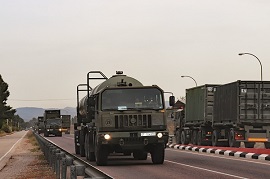
Most of the wheeled vehicles were moved by road and the chain vehicles, by train and góndola.
Some 5.000 military personnel, 290 chain vehicles, 550 wheeled vehicles and 160 containers took part in the exercise. The figures give an idea of its size and importance and also of the logistic complexity involved in mobilising all human and material resources to its various sites.
The Logistics Brigade has been one of the main responsible for making this possible, thanks to the work of some 350 of its members.
This, the Transport Group was responsible for the transport of most of the armoured/mechanised means of the 12th Guadarrama Brigade from its General Staffs in Madrid to Zaragoza, and for their return. This is no mean feat, given that the 12th Brigade mobilised 290 chain vehicles and 332 wheels. It also deployed about 2.500 military personnel and 252 from other platforms (including containers, trailers, etc.) It is not surprising then thatm in order to prepare all the necessary coordination and support for the deployment, the Logistics managers at the General Staff and in the 12th Logistics Group have invested "some seven months" as stated by 1st Sergeant Castrillo, from the Logistics area of the General Staff. Nor that, during the development of the activities, they have had to combine the real day-to-day logistics (food, fuel, ammunition, etc.) with the preparation of the withdrawal.
Fortunately, they have had the invaluable support of a General Support Logistics Complex (COLAG), set up by the 61st Logistics Support Group (AALOG) in San Gregorio, and of a health training type ROLE 2 of the 3rd Health Group.
The 41st AALOG also offered its support, through its fuel and supply centres and its ammunition Company.
In “Chinchilla”, the CGTAD support battalion had the collaboration of the 21st AALOG for showers, watering, maintenance and recovery.
Command Posts exercises (CPX) are used to train unit command and control structures in the planning and conduct of an operation; in the case of the Valiant Lynx, to train a command and control structure from the Corps to the Brigade level, in accordance with the standards of the Atlantic Alliance (NATO published evaluation criteria guide).
Those involved were the HQ NRDC-SP, the "San Marcial" Division, the Field Artillery Command, the 12 "Guadarrama" Brigade and the 11th "España" Cavalry Regiment Command Post.
In this phase, the 12th Brigade reached one of the milestones it had set itself: achieving the integration of the command and control systems of the different units: battalion, the BMS (Battlefield Management System), brigade, the information System for the Command and Contol of the Army (SIMACET) 4. 2 and corps of the Army, the 5.0. This was the first exercise in which integration was achieved at this level, and the 12th Brigade has once again been a pioneer, proving itself to be a "spearhead" in the development of the BMS. This achievement is the culmination of "a work of many years and many people", stressed the Captain Cantalejo, head of the Transmission Company.
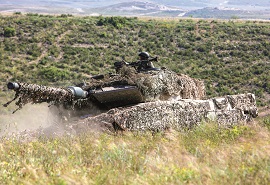
The 12th Brigade deployed all its combat power with its Leopard vehicles.
The live phase (LIVEX) had as main character the 12th Brigade, which was deployed with all its units, practically. Hence, the Chief of Staff of the Brigade and the Advanced Command Post, Lieutenant Colonel Romulo, did not hesitate to refer to it as "the most demanding exercise of recent years for the 12th Brigade".
Its task was to implement the actions envisaged under Elephant Operation, an offensive mission of the multinational force deployed to restore the territorial integrity of a member state. For this purpose, it had four Force units, generated from the units of the Brigade, and with the integration of external capabilities, such as helicopters, Remotely Operated Air Systems (RPAS), Electronic Warfare, NBC or Air Force Aircraft. "Rarely does something like this happen", said Colonel Jiménez, head of the 61st "Alcázar de Toledo" Regiment and second in command of the Brigade. An unparalleled opportunity to "test the comprehensive combat system that is the Brigade, and generate synergies" said General Colomer, its chief.
In addition, during the first days of its deployment in "San Gregorio", the Brigade certified the contingent it will be taking over in Latvia this summer.
On the other hand, both in the CPX and LIVEX phases, an important milestone was achieved: the interoperability of the Fire Support Command and Control System (TALOS) at SIMACET. This was a step prior to Spain's certification as an ASCA nation (Cooperative Artillery Systems Activities).
The LIVEX phase ended with a visit to "San Gregorio" on the last day by the Minister of Defence, María Dolores de Cospedal, accompanied by the JEME, Chief of the General Staff of the Spanish Army, General Varela. There he witnessed two tactical exercises that included real fire and stressed the importance of being interoperable for collective defence.
ARMY UNITS
- Araba Álava |
- Albacete |
- Alicante |
- Almería |
- Asturias |
- Ávila |
- Badajoz |
- Barcelona |
- Burgos |
- Cáceres |
- Cádiz |
- Cantabria |
- Castellón |
- Ceuta |
- Ciudad Real |
- Córdoba |
- A Coruña |
- Cuenca |
- Girona |
- Granada |
- Guadalajara |
- Gipuzkoa |
- Huelva |
- Huesca |
- Islas Baleares |
- Jaén |
- León |
- Lleida |
- Lugo |
- Madrid |
- Málaga |
- Melilla |
- Murcia |
- Navarra |
- Ourense |
- Palencia |
- Las Palmas |
- Pontevedra |
- La Rioja |
- Salamanca |
- Segovia |
- Sevilla |
- Soria |
- Tarragona |
- Santa Cruz de Tenerife |
- Teruel |
- Toledo |
- Valencia |
- Valladolid |
- Bizkaia |
- Zamora |
- Zaragoza





